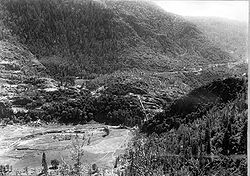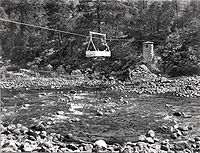- O'Shaughnessy Dam
-
- This article concerns the dam in the Sierra Nevada mountains. For the one near Columbus, Ohio see O'Shaughnessy Dam (Ohio).
O'Shaughnessy Dam 
O'Shaughnessy Dam in Hetch Hetchy ValleyCountry United States Location Hetch Hetchy Valley, California Coordinates 37°56′51″N 119°47′17″W / 37.9475°N 119.78806°WCoordinates: 37°56′51″N 119°47′17″W / 37.9475°N 119.78806°W[1] Construction began 1915 Opening date 1923 Dam and spillways Type of dam Concrete thick arch-gravity Height 426 feet (130 m) Length 900 feet (270 m) Volume 675,000 cubic yards (516,000 m3) Impounds Tuolumne River Spillways 1 Type of spillway Drum gated overflow Spillway capacity 30,000 cubic feet per second (850 m3/s) Reservoir Creates Hetch Hetchy Reservoir Capacity 360,000 acre feet (0.44 km3) Catchment area 459 square miles (1,190 km2) Surface area 1,972 acres (798 ha) Max. water depth 312 feet (95 m) Power station Type Multiple including Moccasin #1 and #2 and Robert C. Kirkwood powerhouses Hydraulic head 1,500 feet (460 m) Installed capacity 500 MW The O'Shaughnessy Dam is a curved gravity dam on the Tuolumne River in the Hetch Hetchy Valley of California's Sierra Nevada. The dam is located in Yosemite National Park, and creates the Hetch Hetchy Reservoir. It is named for former San Francisco chief engineer and the original chief engineer of the Hetch Hetchy Project Michael M. O'Shaughnessy.
The dam provides water and electricity to 2.4 million people in the city of San Francisco, San Mateo County, Alameda County, and the San Joaquin Valley. The power-generation facilities and transmission lines are concealed to protect the valley's famous scenery.
The hydroelectric plant generates about 500 megawatts[citation needed], or 1 percent of California's power use during the summer.[2] The reservoir holds 0.444 cubic kilometres (360,000 acre·ft) of water, of which about one-third is diverted into Canyon Tunnel and the Hetch Hetchy Aqueduct to the San Francisco Bay Area.
The O'Shaughnessy Dam is near Yosemite's western boundary, but the long, narrow, fingerlike reservoir stretches eastward for about 12.5 km (over 8 miles).
Contents
Construction and history
The dam was proposed in 1903, when the city of San Francisco applied to the Department of the Interior for water rights in the area. The Sierra Club resisted for the next ten years. John Muir, its president and founder, declared, "Dam Hetch Hetchy! As well dam for water-tanks the people's cathedrals and churches, for no holier temple has ever been consecrated by the heart of man." The Raker Act of 1913 allowed the flooding of the valley, but debate continues to this day. Construction was completed in 1923. The dam then stood 227 feet (69 m) high; its present height of 312 feet (95 m) was achieved only later in 1938.
The Early Intake (Lower Cherry) Powerhouse began commercial operation five years before the O'Shaughnessy Dam was completed. The first Moccasin Powerhouse in Moccasin, California began commercial operation in 1925 followed by the Cherry Powerhouse in 1960 (the same month the Early Intake Powerhouse was taken out of service). In 1967 the Robert C. Kirkwood Powerhouse started commercial operation followed by a New Moccasin Powerhouse in 1969 when the Old Moccasin Powerhouse was taken out of service. Finally, in 1988, a third generator was added to the Kirkwood Powerhouse.[3]
Disputes and controversies
The Raker Act specified that because the source of the water and power was on public land, no private profit could be derived from the development. One local weekly newspaper says the city of San Francisco is in violation of the law, but according to Peter Byrne, "the plain language of the Raker Act itself and experts who are familiar with the act (and have no stake in city politics) all agree: The city of San Francisco is not in violation of the Raker Act."[4] Harold L. Ickes, Secretary of the Interior in the late 1930s, said there was a violation of the Raker Act, but he and the city reached a final solution in 1945.[5]
The Sierra Club currently advocates removing the dam, but the city of San Francisco opposes, because the reservoir currently serves 2.4 million people, including parts of San Mateo County, Alameda County, and Silicon Valley. Deconstructing the dam would cost from 3 to 9.8 billion dollars, according to a study ordered by Governor Schwarzenegger.[6]
In 1987, the idea of razing the O'Shaughnessy Dam gained an adherent in Don Hodel, then Secretary of the Department of the Interior under President Ronald Reagan. Hodel called for a study of the effect of tearing down the dam. The National Park Service concluded that two years after draining the valley, grasses would cover most of its floor and within 10 years, clumps of cone-bearing trees and some oaks would take root. Within 50 years, vegetative cover would be complete except for exposed rocky areas. In this unmanaged scenario where nature is left to take hold in the valley, eventually a forest would grow, rather than the meadow being restored. However, the same NPS study also finds that with intensive management, an outcome where "the entire valley would appear much as it did before construction of the reservoir" is feasible.[7]
Some observers, such as Carl Pope (Director of the Sierra Club), stated that Hodel had political motives [8] in proposing the study. The imputed motive was to divide the environmental movement: to see residents of the strongly Democratic city of San Francisco coming out against an environmental issue. Dianne Feinstein, the mayor of San Francisco at the time, said in a Los Angeles Times story in 1987: "All this is for an expanded campground? ... It's dumb, dumb, dumb." Hodel, now retired, is still a strong proponent of restoring Hetch Hetchy Valley and now-Senator Feinstein is still strongly against restoration. The Bush Administration proposed allocating 7 million dollars to studying the removal of the dam in the 2007 budget. Dianne Feinstein opposed this allocation, saying "I will do all I can to make sure it isn't included in the final bill. We're not going to remove this dam, and the funding is unnecessary."[9]
See also
References
- ^ "O'Shaughnessy Dam". Geographic Names Information System, U.S. Geological Survey. 2000-06-14. http://geonames.usgs.gov/pls/gnispublic/f?p=gnispq:3:::NO::P3_FID:1652853. Retrieved 2011-01-06.
- ^ Calilfornia Independent System Operator 2010 Outlook - Page 4, Table 1
- ^ "Chronology of San Francisco's Water Development". http://outside.chromoly.net/HHWP/chronology.htm. Retrieved 2010-09-23.
- ^ Byrne, Peter (2001-04-04). "Delusions of Power". San Francisco Weekly. http://www.sfweekly.com/2001-04-04/news/delusions-of-power/.
- ^ Robert W. Righter,"The Battle over Hetch Hetchy" (2005) p. 185
- ^ "Hetch Hetchy Restoration Study". California Department of Water Resources. http://hetchhetchy.water.ca.gov/. Retrieved 2008-06-03.
- ^ Riegelhuth, Richard; Botti, S., Keay, J.. "Alternatives for restoration of Hetch Hetchy Valley following removal of the dam and reservoir page 15". http://www.sierraclub.org/ca/hetchhetchy/nps_hh_restoration.pdf.
- ^ Undamming Hetch Hetchy by Carl Pope - Restore Hetch Hetchy
- ^ Doyle, Michael (2007-02-08). "Hetch Hetchy debate reborn". Sacramento Bee. http://parkwayblog.blogspot.com/2007/02/hetch-hetchy.html.[now in paid archives]
External links
- John Muir on Hetch Hetchy
- Restore Hetch Hetchy web site
- O'Shaughnessy Dam at Structurae
- Native American history of Hetch Hetchy
- San Francisco Public Utilities Commission, Department of Hetch Hetchy Water and Power
- Bay Area Water Supply and Conservation Agency on Hetch Hetchy dam
- Database of California Power Plants
- Map of Bay Cities Water System
Categories:- Dams in California
- Buildings and structures in Yosemite National Park
- Water in California
- History of San Francisco, California
- Hetch Hetchy Project
- Buildings and structures in Tuolumne County, California
- Dams and reservoirs in U.S. National Park Service units
- Dam controversies
Wikimedia Foundation. 2010.


